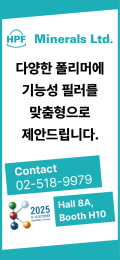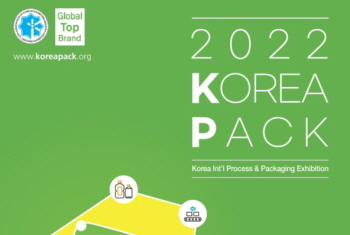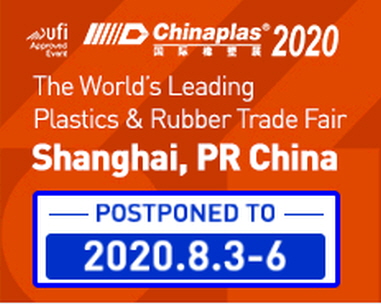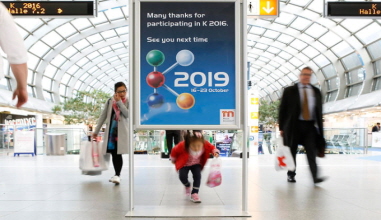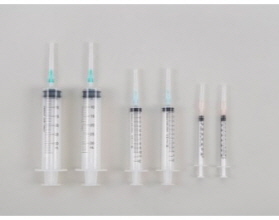Exhibitions/Seminars
Current Status of Waste Plastics Recycling in Korea
At the 42nd Far East Plastic Industry Conference
by Korea Federation of Plastic Industry Cooperatives(KFPIC)
![]()
1. Current Status of Plastic Wastes
In 2015, Korea produced 6.9 million tons of plastic waste, an increase of 0.51 million tons from 2014. The generated plastic wastes grew by an annual average rate of 6.4% over the past five years from 2010 to 2015.
Industrial household waste accounted for 57.5% of the total plastic wastes generated in 2015. Residential wastes(Household and Industrial) and construction waste made up 33.8% and 8.7% respectively. [Table 1 and 2]
The generated Household waste, which are composed of household wastes and “industrial household wastes,” reached 23 millions tons in 2015, an increase of 5.9% from 2014. Household wastes amounted to 1.78 million tons and industrial household wastes stood at 0.54 million tons, up by 4.2% and 11.6% respectively from 2014.
The year 2015 witnessed 3.97 million tons of generated industrial wastes, driven by an increase of 0.35 million tons (9.9%) from 3.61 million tons in 2014. Construction wastes stood at 0.6 million tons in the same year, up by 20,000 tons (4.3%) from the previous year.
2. Current Status of Plastic Wastes Being Processed
The recycling rate of plastic wastes in Korea grew by an annual average of 2.7% over the past five years from 2011 to 2015. Notably, the plastic wastes recycled in 2015 were at 4.11 million tons, up by 7.4% from 2014. Another 2.44 million tons of wastes were incinerated and the other 0.34 million tons of wastes were sent to landfills.
An annual increase in the production of plastic products has led to a growth in the volume of waste for disposal. Notably, the volume of waste going into a recycling process rose by 9.3% over the past five years from 2011 to 2015. On the contrary, the same period saw a fall of 0.7% in the volume of wastes buried in landfills, indicating an increase in the recycling rate. Incineration and burial of plastic wastes were on a declining trend. [Table 3]
Global economic slowdowns in 2015 has led to a fall in the demand for recyclable synthetic resins. In particular, China’s economic weakness put downward pressure on the price of recylable synthetic resins.
The monthly trend of prices of recyclable materials released by Korea Environment Corporation (K-eco) showed that the price of compressed plastic products such as PET plastic bottles went down by half from 600 won to 330 won per kilogram in January 2013. Synthetic resins (e.g. PE pellets, PP pellets, PS pellets, etc.) fell by approximately 20% from 850 won to 600 won in the same month.
Accordingly, the sales volume of synthetic resins stood at 4.48 million tons, up by 64.2% from 2014. However, the total sales value was estimated at one trillion won, down by 24.5% from 2014. This poor performance was driven by the decline in a per-ton price of recyclable synthetic resins. [Table 4] ![]()
3. Current Status of Synthetic Resin Recycling
■ Current Status of Recycling of EPR items
Since 2012, the production volume of PET plastic bottles has grown by an annual average of 6.6%, thus reaching 273,000 tons in 2016. However, the recycling rate of the bottles was 80.5%, down by 1.0%, in the same year.
In 2016, the production volume of polystyrene paper (PSP) was 91,000 tons, 53,000 tons of which was recycled. The recycling rate continued to increase over the past five years from 2012 (up by 0.8%) to 2016 (58.6%, up by 7.5%).
As for synthetic resins, including bowls, trays, and plates, the production and recycling volumes continued a five-year growth trend from 2012 to 2016. Such volumes increased by an annual average of 7.1% and 10.0%, respectively, thus reaching 238,000 tons and 236,000 tons.
The recovery rate of the aforementioned synthetic resins continued to increase from 2014 to 2016, thus pushing the recycling rate to an annual average of 105.3% over the past three years. [Table 6]
In 2016, the analysis was conducted of the shipments and recycling volume of synthetic resins (PSP and PVC items). The findings showed that the recycling rate of PSP was 58.6%, up by 7.6% from 2015, while that of PVC items was 73.7%, down by 5.9% from 2015.
Also, the recycling rate of items such as trays and bowls was 99.0%, down by 14.3% from 2015, while that of films reached 106.7%, up by 16.7%. [Table 7]
■ Voluntary Agreement for Plastic Waste Recovery & Recycling
Plastic manufacturers and the Ministry of Environment signed the Voluntary Agreement on Recovering and Recycling of Plastic Wastes to promote the recycling rate of plastic wastes. Under the Agreement, signed plastic manufacturers are exempted from bearing expenses for disposing of plastic wastes. The Agreement, which covered eight plastic items in 2008, provided such exemption benefits to manufacturers for 26 plastic items in 2013.
However, as the Government introduced such programs as the Extended Producer Responsibility (EPR) and the Eco-Assurance System of Electrical and Electronic Equipment and Vehicles (EcoAS) in 2014, plastic items of a lower recycling rate were excluded from the list of exemption items covered by the Agreement. As a result, 14 items, including an electric rice cooker, were removed from the list in 2015, which left a total of 10 items on the list.
In 2016, 14 items were included in the list with an addition of PE films for agricultural use, industrial films, dehumidifiers, and household appliances. Also, a total of 1.15 million tons of plastic products were released onto the market, and 315,000 tons of such products were recovered and recycled. [Table 8]
The total recycling rate of 14 items on the exemption list was 113.9% in 2016. As for insulating materials and dehumidifiers, the recycling rate for each, 85.6% and 23.5% respectively, fell short of the target. However, items such as palettes and containers exceeded their target by recording a recycling rate of 120.4%. [Table 9]
4. Conclusion
Starting from January 2018, Korea plans to implement the Resources Circulation Basic Act to help create a society where resources are circulated. The make-or-break factor in this Act is determined by removing an obstacle of causing a bottleneck situation in the waste circulation process ranging from (a) separating and selecting of wastes to (b) producing of recycling resources to (c) consuming of finished products. In other words, recyclable products should be processed with recycling resources, after which such products should be efficiently and effectively circulated into a new product or fuel.
The Korean government and a private organization jointly built a household waste-fired power plant in 2013 to enhance the effective utilization of the energy from wastes. The power plant turns household wastes into solid refuse fuel (SRF) and burns the fuel at an advanced combustion furnace to produce thermal energy (steam). This thermal energy is turned into electricity. The public-private consortium sells the electricity to Korea Electric Power Corporation and provides the remaining part of the thermal energy for industrial consumers.
As shown above, the Korean government has been carrying out a national plan on “Energy Strategy for Use of Wastes and Biomass” since 2009. The government has set a target rate of 4.16% by 2020 in terms of the energy supply generated from wastes and biomass. This is part of the efforts to reach a target rate of 6.08% by that year in the supply of new renewable energy. The 4.16% figure, accounting for 68% of the new renewable energy, carries significance that energy from wastes plays a crucial role in achieving the supply target rate of new renewable energy.
However, the reality is that the Korean government has no measures to promote the use of biomass energy, a stark contrast from the case of Japan and Germany. Moreover, there is no system in place to facilitate cross-sectoral collaboration. Thus, demand is growing that efforts need to be made urgently to address such challenges.
Also, despite the advantages and benefits of affordable prices and higher heating value, biomass energy emits excessive exhaust fumes and ordor. Thus, there is a growing demand for stricter regulation of air pollution.
The Korean government should enhance the effective utilization of biomass fuel by improving relevant systems as well as adopt an entry strategy of acquiring biomass resources. The government should also introduce the following exit strategies: (a) operation of a feed-in tariff program, (b) provision of reliable consumers, (c) prevention of possible risks that local governments may experience by applying new technologies, (d) the government’s provision of R&D funds for the private sector to promote the development of advanced technologies, and (e) establishment of relevant guidelines.
The protracted trend of declining oil prices has weakened the economic feasibility of energy generated from wastes and biomass and thus diverted global attention from it. However, enterprises and research institutes are working harder than ever to take a leading position in the upcoming era of resource circulation. The eyes of the world are now on whether the Resources Circulation Basic Act, which is expected to be enforced in 2018, will serve as a catalyst to promote the trend of turning wastes into energy.


